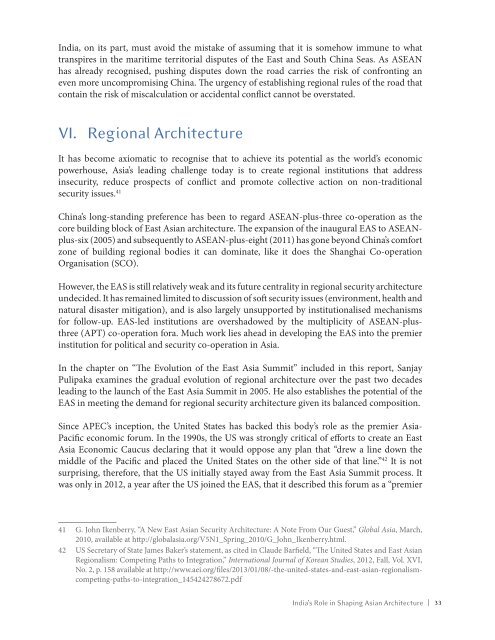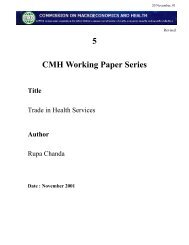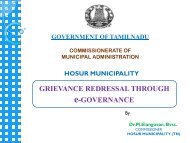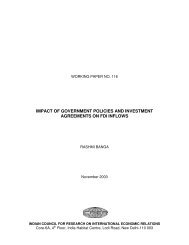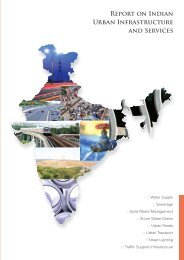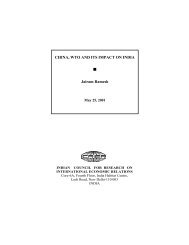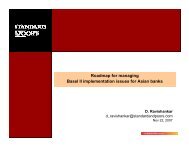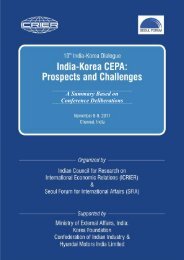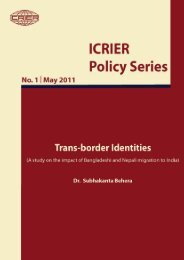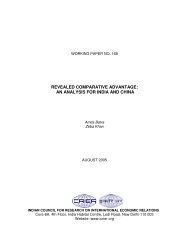Asia's Arc of Advantage - icrier
Asia's Arc of Advantage - icrier
Asia's Arc of Advantage - icrier
You also want an ePaper? Increase the reach of your titles
YUMPU automatically turns print PDFs into web optimized ePapers that Google loves.
India, on its part, must avoid the mistake <strong>of</strong> assuming that it is somehow immune to what<br />
transpires in the maritime territorial disputes <strong>of</strong> the East and South China Seas. As ASEAN<br />
has already recognised, pushing disputes down the road carries the risk <strong>of</strong> confronting an<br />
even more uncompromising China. The urgency <strong>of</strong> establishing regional rules <strong>of</strong> the road that<br />
contain the risk <strong>of</strong> miscalculation or accidental conflict cannot be overstated.<br />
VI. Regional <strong>Arc</strong>hitecture<br />
It has become axiomatic to recognise that to achieve its potential as the world’s economic<br />
powerhouse, Asia’s leading challenge today is to create regional institutions that address<br />
insecurity, reduce prospects <strong>of</strong> conflict and promote collective action on non-traditional<br />
security issues. 41<br />
China’s long-standing preference has been to regard ASEAN-plus-three co-operation as the<br />
core building block <strong>of</strong> East Asian architecture. The expansion <strong>of</strong> the inaugural EAS to ASEANplus-six<br />
(2005) and subsequently to ASEAN-plus-eight (2011) has gone beyond China’s comfort<br />
zone <strong>of</strong> building regional bodies it can dominate, like it does the Shanghai Co-operation<br />
Organisation (SCO).<br />
However, the EAS is still relatively weak and its future centrality in regional security architecture<br />
undecided. It has remained limited to discussion <strong>of</strong> s<strong>of</strong>t security issues (environment, health and<br />
natural disaster mitigation), and is also largely unsupported by institutionalised mechanisms<br />
for follow-up. EAS-led institutions are overshadowed by the multiplicity <strong>of</strong> ASEAN-plusthree<br />
(APT) co-operation fora. Much work lies ahead in developing the EAS into the premier<br />
institution for political and security co-operation in Asia.<br />
In the chapter on “The Evolution <strong>of</strong> the East Asia Summit” included in this report, Sanjay<br />
Pulipaka examines the gradual evolution <strong>of</strong> regional architecture over the past two decades<br />
leading to the launch <strong>of</strong> the East Asia Summit in 2005. He also establishes the potential <strong>of</strong> the<br />
EAS in meeting the demand for regional security architecture given its balanced composition.<br />
Since APEC’s inception, the United States has backed this body’s role as the premier Asia-<br />
Pacific economic forum. In the 1990s, the US was strongly critical <strong>of</strong> efforts to create an East<br />
Asia Economic Caucus declaring that it would oppose any plan that “drew a line down the<br />
middle <strong>of</strong> the Pacific and placed the United States on the other side <strong>of</strong> that line.” 42 It is not<br />
surprising, therefore, that the US initially stayed away from the East Asia Summit process. It<br />
was only in 2012, a year after the US joined the EAS, that it described this forum as a “premier<br />
41 G. John Ikenberry, “A New East Asian Security <strong>Arc</strong>hitecture: A Note From Our Guest,” Global Asia, March,<br />
2010, available at http://globalasia.org/V5N1_Spring_2010/G_John_Ikenberry.html.<br />
42 US Secretary <strong>of</strong> State James Baker’s statement, as cited in Claude Barfield, “The United States and East Asian<br />
Regionalism: Competing Paths to Integration,” International Journal <strong>of</strong> Korean Studies, 2012, Fall, Vol. XVI,<br />
No. 2, p. 158 available at http://www.aei.org/files/2013/01/08/-the-united-states-and-east-asian-regionalismcompeting-paths-to-integration_145424278672.pdf<br />
India’s Role in Shaping Asian <strong>Arc</strong>hitecture | 33


